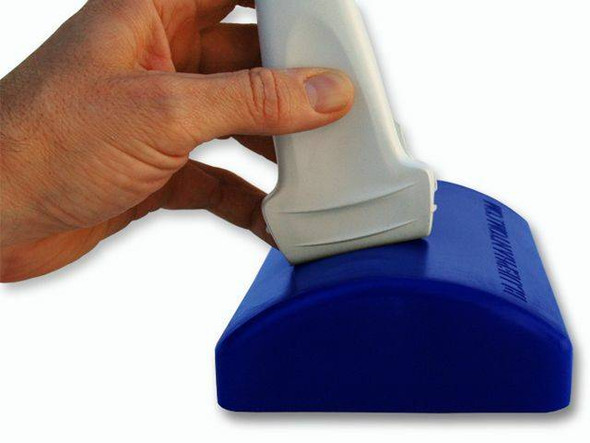Description
Blue Phantom's Generation II Femoral lower torso ultrasound guided regional anesthesia and central venous access training model is an excellent tool to train users to develop and practice the skills necessary to gain proficiency in using ultrasound for regional anesthesia procedures of the femoral nerve as well as guide catheter insertions in the femoral artery and vein. Built upon the feedback we received from our customers of our first generation femoral model, we have developed the most realistic Femoral Ultrasound trainer available in the market today. Using Blue Phantom simulated human tissue, this very realistic and ultra-durable ultrasound training phantom is an excellent choice for training clinicians in the psychomotor skills associated with ultrasound guided regional anesthesia as well as vascular access procedures. These ultrasound imaging skills include; using ultrasound system controls, transducer positioning and movement, recognition of nerves, arterial and venous anatomy, using ultrasound to target the femoral nerves for regional anesthesia procedures, guide needles to blood vessels for cannulation, and performing vascular access procedures. Comprised entirely of our patented Simulex self-healing tissue, users can access vessels on both limbs resulting in twice the number of access sites compared to the original model. With our innovative new hand pump system, the femoral artery no longer collapses creating our most realistic anatomy yet. We know that gaining the psychomotor skills to perform ultrasound guided procedures requires practice. Our ultra-durable self-healing tissue will allow you to repeatedly perform ultrasound guided regional anesthesia nerve blocks and central venous access procedures without giving second thought to who or when you train or calculating the cost for each training session. Whether you are learning to use ultrasound to guide needles, perform nerve blocks and vascular access procedures, or troubleshoot difficult catheter placements, you can expect unmatched durability from our nerves, tissue and vessels. Blue Phantom ultrasound training mannequins are constructed using patented ultra-durable tissue and are extremely realistic in ultrasound imaging characteristics and feels like real human tissue. Our self-healing tissue will withstand tremendous use and will save you money by dramatically reducing the necessity for purchasing replacement parts. Realism makes your training better. Each model offers anatomically correct femoral nerve as well as the fascia iliaca nerve. Vascular anatomy as well as anatomical landmarks of the lower torso. Vascular Anatomy includes: Aorta, Inferior Vena Cava (IVC), Common Iliac Artery and Vein, Internal Iliac Artery and Vein, Femoral Artery and Vein, Great Saphenous Vein. Users can utilize traditional anatomical landmarks such as the Pubic symphysis, Iliac Crest and Inguinal Ligament for blind venous access insertion techniques, or utilize ultrasound to obtain images of pertinent anatomical structures. The model is equipped with a hand pump used to create arterial pulsations which can help users differentiate between arteries and veins as well as providing internal reference points for regional anesthesia procedures. Positive fluid flow in the vessels provides users with immediate feedback when vessels are accessed. Simulated anesthetics can be injected into the mannequin to aid the user in learning to perform the entire ultrasound guided nerve block procedure. Injected fluids are automatically expelled so that the model can be used repeatedly for training. The color of the simulated blood fluids in the arterial vessels differ from the venous system allowing for users to easily differentiate between successful venous access procedures. Collapsible Venous anatomy with mild pressure also aids in distinguishing artery from the vein. Venous and arterial fluids that are removed during central catheter insertions training are easily refilled using quick fill ports. While performing vascular access central catheter procedures, internal vessels accommodate the full threading of guidewires and catheters. Our tissue looks, feels and images like human tissue. At Blue Phantom we expend tremendous effort to match the imaging characteristics of real human tissue allowing you to teach and train under optimal conditions. We know that the best simulation training scenarios are requisite on users experiencing the same procedural realism as performing the procedure on patients. All of our simulation materials match the acoustic characteristics of real human tissue so when you use your ultrasound system on our training models, you experience the same quality you expect from imaging patients in a clinical environment. Use your own ultrasound system for simulation training. This medical simulation trainer will perform well using any ultrasound imaging system configured with the appropriate transducer (recommended ultrasound transducer; high frequency linear array ultrasound probe 5.0 - 12 MHz). This ultrasound phantom model is excellent for specialties including anesthesiology (anaesthesiology), cardiology, emergency medicine, radiology, surgery, surgical training programs, ultrasound training programs, simulation centers, surgical skills centers, medical education facilities, and ultrasound manufacturers for ultrasound education and demonstrations.
Additional Information
Best Uses: |
Practical Skills Training, Medical Education |
Product Class: |
Top-Tier |

































